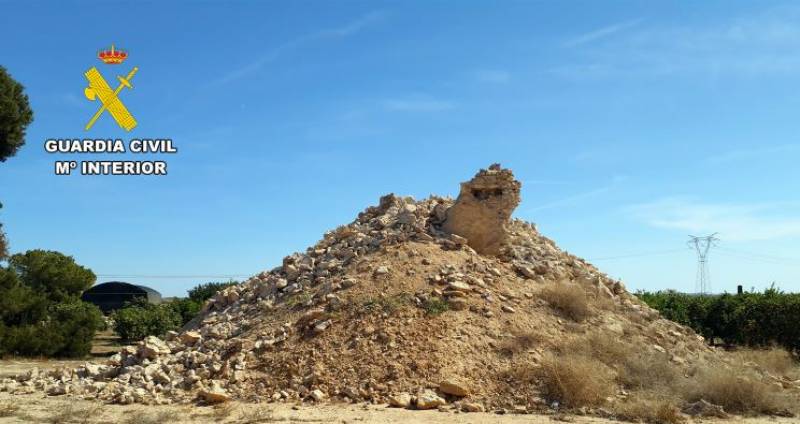

- EDITIONS:
 Spanish News Today
Spanish News Today
 Murcia Today
Murcia Today
 Alicante Today
Alicante Today
article_detail
Spanish News Today Editors Roundup Weekly Bulletin June 21

TOP STORIES: "Summer is finally here!" & "What the different coloured beach flags mean in Spain"
It’s finally summer! Time to crack the suncream out (but only the right kind), put away the long sleeves and closed-toe shoes for the next few months and hit the beach or pool every day.
We’ve got a special section for you this week about the summer solstice and how it ties into this weekend’s San Juan celebrations which will be taking place up and down the country, plus important information everyone should know about the beaches here in Spain and the sad ongoing story of Jay Slater, the British teen who went missing in Tenerife at the beginning of this week.
Hello summer (for real this time!)
Three weeks ago, we had a section in our Editor’s Roundup Weekly Bulletin entitled ‘Hello summer!’ which talked about the beginning of the really hot weather in Spain this year. Well, that was a little bit misleading because it wasn’t even summer yet at that point. Now it is.
The astronomical summertime started yesterday, Thursday June 20, on the Summer Solstice, specifically at 11.51pm last night, Spanish time.
The solstice, of course, is the time when the day is at its longest point and the night is shortest. (Conversely, the winter solstice is the day of the year with the longest night and the shortest day.)
It’s a time that is traditionally associated with magic, druids, nature worship and wiccans, and there are gatherings at dolmens, cromlechs and other standing stones to mark the occasion.

In the UK this week, Just Stop Oil protestors launched orange powder paint at the world’s best-known dolmen structure, Stonehenge.
In Spain, the summer solstice is more closely linked with the Catholic Feast of San Juan. San Juan is actually celebrated on June 24 each year, but the night before, known as the Noche de San Juan, is when the main celebration takes place, frequently involving bonfires on the beach and sometimes people jumping over the fires (‘hogueras’) to banish evil spirits.
This year, the Noche de San Juan falls on Sunday, so a word of advice – don’t go down to the beach first thing on Monday morning because it’s bound to be full of half-empty beer bottles, cigarette butts and other waste until cleaning crews have had a chance to tidy up after the all-night partying.
For most people, though, summer already felt like it started a full week ago or more with the increasingly warm weather. As the kids get out of school in provinces around Spain and countries around Europe, heralding the annual migration of people to the coast for their holidays, it will feel more and more like summer.
For people who work in Spain, July and August are the major months as many businesses switch to the ‘horario de verano’, when a full-time working day consists of 6 or 7 hours worked rather than 8.
Some will also require their employees to take up to 60% of their annual leave in these summer months since it is a) too hot to work much past midday and b) a time when there is not much business happening anyway.
Except for hotels, bars and restaurants, of course. They do a roaring trade in summer, catering to all the tourists, domestic and international, and they will be welcoming the start of the fat season too.
Whatever you’re doing this summer, please be safe when it comes to dealing with the heat and swimming at beaches and in pools. We already have to bring you enough news stories about drownings, and death caused by extreme heat is a real thing. Please don’t become one of the statistics!
Drink plenty of water, make sure children are always supervised in the water and stay out of the water if it looks choppy.
Talking of which…
What the different coloured beach flags mean in Spain

Spain’s expansive coastline, stretching more than 8,000 kilometres, boasts a stunning array of more than 3,000 beaches. Each summer, these sun-soaked shores become a haven for travellers seeking fun, relaxation and a dip in the refreshing waters. However, amidst the excitement, it’s crucial to prioritise safety, and that’s where the coloured flags come into play.
The Red Cross and Civil Protection personnel are the guardians of Spain’s beaches, hoisting flags daily to inform beachgoers about the sea conditions and whether it’s safe to swim. These flags are more than just colourful displays; they are a vital form of communication that can mean the difference between life and death.
Each year, tragedies occur when these warning signs go unnoticed or are misunderstood. To ensure your safety and a pleasant beach experience, it’s essential to familiarise yourself with the flag system before diving into the waters.
The 4 main flags
- Green: This colour signifies that bathing in the sea is permitted and the water conditions are ideal for swimming. Go ahead and enjoy a refreshing dip.
- Yellow: While swimming is allowed, caution is advised due to potential waves, strong currents, pollution or marine animals. Stay within your depth and always keep an eye out for any changes in the water.
- Red: This is the most critical flag, indicating that swimming is strictly prohibited. A red flag means there is a high risk to your safety due to adverse conditions such as strong waves, treacherous currents or the presence of dangerous animals like sharks. Stay on the sand and admire the beauty from a distance.
- Orange: This flag signals that the lifeguard is not on duty, so swimmers should exercise caution and be aware of potential risks.
Other flags
In addition to the four primary flags, there are other official flags used on Spanish beaches:
- Black: A stark warning, the black flag indicates that the beach is closed due to safety risks. Entering the water is prohibited, and in some cases, even walking on the sand may be restricted.
- Blue: The coveted Blue Flag is a seal of excellence, awarded to Spain’s best beaches. It signifies exceptional water quality, top-notch facilities, security, accessibility and environmental protection.
- Jellyfish flag: This flag, often featuring jellyfish illustrations, warns swimmers about the presence of these stinging creatures in the water.
- Yellow with black dot: Boats and surfboards are not allowed when this flag is flying.
- Black and white chequered: A warning to swimmers, this flag indicates a designated surf zone where swimming could be dangerous.
- White and blue: A signal to boaters, this flag marks a diving area where they must refrain from passing through.
As you plan your Spanish beach getaway, remember to keep an eye out for these colourful flags. They are more than just decorations; they are vital tools for a safe and enjoyable beach experience. So, before you dive into the alluring waters, take a moment to understand the language of the flags – it could just save your life!
Finally, there is another – informal – type of beach flag that you probably won’t see flying but which beachgoers dread.
The annual Black Flags report by Ecologists in Action identifies Spanish coasts that fall short of acceptable standards. This year, after a comprehensive inspection of more than 8,000 kilometres of coastline, the group has assigned a total of 48 black badges nationwide, with a particular focus on the coasts of the Canary Islands due to tourist development and urban sprawl.
Just over a month after the Valencian Community received the most Blue Flags in Spain, four beaches in the province of Alicante have been condemned for mismanagement, including Cabo de las Huertas, Albufereta, Postiguet and San Gabriel.
Additionally, El Campello’s El Amerador beach and ravine have been flagged for high levels of pollution, attributed to faecal discharges on two separate occasions in March and April 2024.
In terms of the four blacklisted beaches, the flags have been bestowed because of “the massive arrival of waste washed into the sea from this enclave of the macro-urbanised coast in the face of the bad conservation and deficiencies in the channelling systems, collectors and outlets, with untreated water reaching the Mediterranean, dragging sediments and waste in its wake, evident by the large number of toilet wipes and plastic bags”.
Ecologists in Action say they have already reported this situation to Seprona and point out that Alicante City Council “is not assuming responsibility as it is passing the buck and justifies this contamination with marine currents, meteorological phenomena and, to a lesser extent, incivility. And it is wiping off the blame by generating greenwashing by launching campaigns to clean up the city with wipes.”
British teen missing in Tenerife
 The disappearance of 19-year-old British tourist Jay Slater in Spain has authorities and loved ones alike deeply concerned. Jay, an apprentice bricklayer from Oswaldtwistle in Lancashire, vanished without a trace on June 17 after a night out in the rugged terrain of Tenerife.
The disappearance of 19-year-old British tourist Jay Slater in Spain has authorities and loved ones alike deeply concerned. Jay, an apprentice bricklayer from Oswaldtwistle in Lancashire, vanished without a trace on June 17 after a night out in the rugged terrain of Tenerife.The young man had travelled to the Canary Island with friends, including his companion Lucy Mae, to attend the NRG music festival. However, in an unfortunate turn of events, Jay's last known location was near Rural de Teno Park, an isolated and mountainous area in the northwest corner of the island.
According to Lucy Mae, Jay made a distressing phone call shortly before 9am on Monday, revealing that he was attempting the arduous 10-hour walk back to their accommodation in the south. His phone battery was dwindling at 1%, and he urgently needed water. Sadly, the call abruptly cut out, and Jay has not been heard from since.
The search for the missing teen has been relentless, with search teams, relatives and friends scouring the challenging terrain. Slater’s mother, Debbie Duncan, described his disappearance as “an absolute living nightmare”. She praised the local police and mountain rescue teams for their tireless efforts, utilising drones and dogs in their search.
As the days go by without a trace of Jay, the concern for his well-being grows. His loved ones are desperate for any information that could lead to his safe return. Anyone with information about Jay’s whereabouts is urged to come forward and contact the authorities.
Murcia
We start our Murcia section with sad news coming out of Torre Pacheco, where the Guardia Civil are investigating a serious crime after one of the area’s protected windmills was knocked down illegally. The windmill, which has been registered as an Asset of Cultural Interest since 2009, was among the well-preserved structures in the Campo de Cartagena area, many of which date back to the 18th century, and some even as far back as the 16th century.

The destruction was reported back in March by citizens and the Association of Windmills, prompting police to arrest two individuals, the owners of the land where the windmill stood. They have been charged with failing to conserve and safeguard the monument, violating Murcia’s Cultural Heritage Law, which mandates the protection of such assets.
It’s just as bad in Lorca, where the Life LynxConnect project faced another setback following the death of a reintroduced Iberian Lynx named Ulea, who was shot by a hunter. Ulea was part of a conservation effort to reintroduce lynxes to the Lorca highlands, but his body was found with a gunshot wound last month.
This is the second lynx to be killed by a poacher in less than a year, following the death of Tejo in August 2023. Authorities are now interviewing local hunters to find the culprits, while environmental organisations WWF Spain and ANSE have called for urgent measures to address the poaching problem, which has led to a significant increase in lynx deaths.
Iberian Lynx populations have just been recategorised from ‘at risk of extinction’ to merely ‘vulnerable’, which is a positive, but overall the project to reintroduce the lynx to Lorca’s highlands has been far from a success. There has been a high attrition rate, mainly because the area they are released into is not far away enough from busy roads and human populations. And yet, they continue to release more of them without stopping to consider that maybe their approach needs a rethink…
 Still, there’s promising news from the Mar Menor, which is experiencing a jellyfish baby boom, particularly of the fried egg jellyfish species (C. tuberculata). The Regional Government’s Fisheries and Aquaculture Service has reported large numbers of juvenile jellyfish, known as ephyrae, at various sampling points.
Still, there’s promising news from the Mar Menor, which is experiencing a jellyfish baby boom, particularly of the fried egg jellyfish species (C. tuberculata). The Regional Government’s Fisheries and Aquaculture Service has reported large numbers of juvenile jellyfish, known as ephyrae, at various sampling points.While that may not sound like good news at first (who wants to swim surrounded by jellyfish?), the truth is that this species of jellyfish is harmless to humans and, combined with the news of growing seahorse and mussel populations that we brought you two weeks ago, the current population explosion is a good indicator of the improving health of the lagoon and proof that it can support life.
As the summer season ratchets up, more and more tourists will be coming to Murcia to rent a holiday home by the beach, whether it’s around the Mar Menor or on the southern Mediterranean coast. During the peak summer season, finding affordable beach-side rentals can be challenging due to high demand and premium prices.
That’s why consulting company Tecnitasa has been nice enough as to reveal which Murcia town offers the most cost-effective options for holidaymakers when it comes to renting a beach house.
You may or may not be surprised to know that the municipality of Águilas provides the best value for money, with weekly rental prices significantly lower than the national average. An apartment with sea views in Isla del Fraile, for example, costs around 700 euros per week, while a rental in Calabardina averages 600 euros. Playa de La Colonia is the cheapest, with a 90-square-metre apartment going for 550 euros per week.
Águilas is an attractive destination not only for its affordability but also for its beautiful beaches and amenities, not least of which are golf courses, another major pull for people coming to visit Murcia.
In fact, the beautiful beaches of the Region of Murcia have just added two more feathers to their caps, securing a total of 47 ‘Q for Quality’ and 34 ‘S for Tourism Sustainability’ flags at the 2024 awards. In this last category, Murcia actually scored the most of any autonomous community in the country.
Go on Murcia!
Don’t forget to check out our EVENTS DIARY for San Juan celebrations coming up this weekend, and other activities taking place:
Spain
Plenty of hearts came close to stopping on the Canary Islands last weekend when a usually peaceful beach became the scene of a real-life Hollywood thriller. A huge shark appeared, daringly close to the shore, prompting emergency evacuations.
It was a typical sunny day in Gran Canaria when, without warning, at least two enormous sharks decided to venture alarmingly close to the shore, sending swimmers into a panic.
Nuevo avistamiento tiburón martillo pic.twitter.com/ZMmpj8YVDf
— Policía Local Telde (@PoliciaTelde) June 16, 2024
The first encounter occurred on Saturday afternoon, June 15, at Melenara beach in Telde. A swift-moving shark, measuring an impressive two metres in length, charged towards the coast, catching unsuspecting bathers off guard. The Proactiva rescue service leaped into action, deploying a jet ski to track the elusive predator, but despite their valiant efforts, the shark could not be located.
As a precautionary measure, red flags were hoisted, signalling a temporary ban on bathing.
The drama escalated on Sunday June 16, as another shark was spotted at the Balcón de San Agustín. This time, Red Cross volunteers confirmed the unwelcome visitor after a thorough inspection.
Authorities, leaving nothing to chance, promptly prohibited swimming in the cove. The million-dollar question on everyone’s minds: was this the same rogue shark from Telde, now on a coastal tour?
Adding to the intrigue, the local police drone unit from Telde confirmed the presence of not one but two sharks. A second shark, identified as a hammerhead, was spotted prowling the waters near Melenara beach in the afternoon.
While shark sightings in the Canary Islands are not a daily occurrence, the islands’ rich marine ecosystem is home to several shark species. Hammerhead sharks, blue sharks and mako sharks are among the frequent finned residents of these Atlantic waters.
However, most shark species found near the coast are not interested in making humans their main course. They’re just curious creatures exploring their vast territory.
 The Spanish food authorities have intercepted a batch of UK-imported breakfast cereals at the border due to alarmingly high levels of a dangerous toxic substance, setting off alarms across Europe.
The Spanish food authorities have intercepted a batch of UK-imported breakfast cereals at the border due to alarmingly high levels of a dangerous toxic substance, setting off alarms across Europe.The villain of the piece is Ochratoxin A, a nasty little number produced by Penicillium and Aspergillus fungi. It’s a silent threat with a nasty punch – known for its harmful effects on nerves, the immune system, genes and overall health. It has even been linked to cancer in animal studies.
The biggest problem, though, is that we don’t know which brand or factory is responsible for these contaminated cereals. Spain is scrambling to ensure that none of the contaminated products remain on supermarket shelves, while FACUA-Consumers in Action continues to criticise the EU for the lack of information being released.
In a ground-breaking ruling, Spain’s Constitutional Court has upheld a reform of the abortion law, allowing 16- and 17-year-olds to make their own decisions about terminating pregnancies without parental consent. This decision comes after a challenge by the far-right Vox party, citing potential violations of constitutional freedoms and rights.
The reform maintains the 2010 law’s deadlines, permitting abortions during the first 14 weeks of pregnancy and up to 22 weeks in cases of foetal anomalies or risks to the mother's health. After 22 weeks, termination is allowed only for fatal foetal abnormalities or extreme cases with an incurable disease.
The new measures grant women aged 16 and above autonomy over abortion decisions, removing the requirement for parental consent. All public health centres in Spain are now mandated to offer abortions, but a registry of conscientious objectors will be created. The reform also extends reproductive rights to transgender individuals with the capacity to gestate.
Additionally, the law introduces several new rights, including temporary time off for painful periods, disability payments from the 39th week of pregnancy and free menstrual products in educational institutions, prisons and social centres.
It guarantees public access to contraception and promotes co-responsibility in reproductive health. Affective-sexual education will be integrated into the compulsory education curriculum.
To protect women’s sexual and reproductive health, the reform criminalises forced sterilization, contraception, abortion and surrogacy. Advertising by surrogacy intermediation agencies is also prohibited, as the practice is still illegal in Spain.
Alicante
It’s that time of year again when the Mediterranean coast braces for some special visitors – expecting loggerhead turtle mums. These amazing creatures will be making their way ashore in the coming weeks, on a mission to find the perfect sandy spot to lay their eggs.
And the good news is, they’ve already been spotted on the Orihuela Costa, with one mother-to-be checking out Playa de la Glea in Campoamor, and another’s tracks found on Playa les Ortigues in Guardamar del Segura.
Loggerhead turtles are a protected species, so they’ve got a team of dedicated volunteers watching their backs (or shells, in this case!).
 This year, the turtle conservation efforts in Alicante have an extra-furry twist – two canine recruits from the Oceanogràfic Foundation have joined the team. These specially trained dogs are here to lend their extraordinary skills in locating and protecting sea turtle nests along the coast.
This year, the turtle conservation efforts in Alicante have an extra-furry twist – two canine recruits from the Oceanogràfic Foundation have joined the team. These specially trained dogs are here to lend their extraordinary skills in locating and protecting sea turtle nests along the coast.Last week, at Pinedo dog beach in Valencia, this dynamic duo showed off their impressive talents. Trained by animal behaviour specialists, they successfully located simulated sea turtle nests during a demo. Using their super-sniffers, they identified the nests and then sat down to let everyone know they’d found something.
All of this is part of the ‘Turtles in the Mediterranean 2024’ awareness campaign. This campaign is now in its fifth edition and aims to educate folks on what to do if they spot an injured sea turtle along the coasts of the Valencian Community, the Region of Murcia, Andalucia and the Balearic Islands.
Meanwhile, an international collaboration between marine mammal specialists from Oceanogràfic in Valencia and their counterparts at the Georgia Aquarium and SeaWorld in the United States has led to a successful rescue operation for two beluga whales from the NEMO Dolphinarium in Kharkiv, Ukraine. This mission was particularly urgent due to the devastating impact of the ongoing conflict in the region.
The city of Kharkiv has endured frequent bombings, with explosions occurring within a kilometre of the NEMO aquarium. Recognising the imminent danger, the rescue team embarked on a complex and meticulously planned operation to ensure the whales’ safe evacuation.
The two beluga whales, a 15-year-old male named Plombir and a 14-year-old female named Miranda, endured a challenging journey from the war zone. They arrived at the Oceanogràfic in Valencia on the night of June 18, exhibiting signs of stress and requiring immediate care.
✨🌊 Rescatadas con éxito dos belugas de un acuario de Járkov, en Ucrania, y trasladadas al Oceanogràfic de Valencia#Oceanogràfic #Beluga #RescateBeluga #Ucrania pic.twitter.com/PefvH7BSpR
— Oceanogràfic València (@Oceanografic_vl) June 19, 2024
Oceanogràfic, the largest aquarium in Europe, is the only facility on the continent equipped to house beluga whales. Its proximity to Ukraine and accreditation from leading international organisations in animal welfare made it the ideal location for the whales’ rehabilitation and long-term care.
Since the onset of the conflict in 2022, the NEMO Dolphinarium has worked diligently to relocate its animals, including seals, sea lions and dolphins. However, the transfer of beluga whales presented unique logistical challenges due to their size and specialised needs, necessitating months of meticulous planning and the expertise of international specialists.
“When wildlife is in danger, aquariums and zoos are often called upon for their expertise and skills in animal care. It’s not just what we do, it’s who we are,” said Dan Ashe, President and CEO of the Association of Zoos and Aquariums (AZA).
On a grimmer note, a gruesome discovery that shocked the whole of Spain was made last Monday on a country road in Alicante. A jogger stumbled upon a dismembered and burned corpse, missing its head, legs and arms, in the La Serreta de Fontnivel area of the municipality. The body, which was still smouldering, was accompanied by a suitcase filled with clothes.
Preliminary examinations suggest that the victim is male, but a post-mortem examination will be conducted to definitively determine the sex and cause of death. Unfortunately, due to the extensive burning, DNA identification will not be possible.
The National Police Corps have launched an investigation and are diligently searching the surrounding area for any remaining body parts or evidence that could aid in their inquiries.
The early hypothesis points towards a gang-related murder, but authorities are exploring all avenues to uncover the truth behind this heinous crime.
Andalucía
 Almería is set for more changes to its travel infrastructure as part of the ongoing project to introduce the high-speed AVE rail. The Estación Intermodal, a combined bus-and-train station opened as recently as 2005, will be demolished starting this July to make way for a new station.
Almería is set for more changes to its travel infrastructure as part of the ongoing project to introduce the high-speed AVE rail. The Estación Intermodal, a combined bus-and-train station opened as recently as 2005, will be demolished starting this July to make way for a new station.This move is part of a larger plan to connect Almería with Madrid and the rest of Spain via high-speed rail. A new bus station has already been constructed behind the original train station from 1893.
The new train station, which includes a 1.9-kilometre underground access tunnel, will feature a below-ground car park, six tracks and will also house a new bus station for long-distance coaches and city buses, integrating Almería into the high-speed network and the Mediterranean Corridor.
The demolition date for the existing station is still uncertain, but bus operations will be moved within the next month. Currently, trains to Almería stop at the Huércal-Almería station, with passengers taking a replacement bus service to the city.
Travellers from Almería will soon have a new, affordable way to reach Paris, as FlixBus launches a new route from the Andalusian city to the French capital on June 27. Tickets are priced as low as 43.99 euros each way, but it’s not for the faint of heart as the journey takes a staggering 26 hours.
The route not only connects Almería to Paris but also passes through scenic French towns such as Biarritz, Bordeaux, and Tours, providing a picturesque travel experience.
However, this new route has limitations due to regulatory issues. Tickets are only available for international travel, preventing passengers from using the service for domestic trips within Spain.
FlixBus has criticised this restriction, attributing it to the Spanish Government’s non-compliance with European regulations. This limitation means missed opportunities for direct connections within Spain, such as from Almería to Pamplona or Zaragoza.
Finally, in Vélez-Málaga on the Costa del Sol, the town hall has proposed an innovative solution to the ongoing problem of water scarcity by seeking permission to use seawater for its beach foot showers. The town has not had operational beach showers for the last two summers now, but earlier this month the town hall announced that showers and footbaths will be available at the six specially adapted beaches for people with reduced mobility this summer.
Officials have urged beachgoers to use these facilities responsibly and this initiative to start using sea water, as opposed to fresh water or water that is safe for human consumption, is part of a broader effort to ensure the optimal use of limited water supplies.
It’s not an entirely unprecedented move as the use of seawater for footbaths is already implemented in parts of Valencia, but if your aim when leaving the beach is to wash the salt off your feet as well as the sand it doesn’t really *ahem* hold water.

You may have missed…
- Wildfire sweeps through Orihuela Costa golf course.
Panic has swept across Alicante’s Orihuela Costa as videos flood social media of an out-of-control wildfire consuming the brush land between the Campoamor and Las Ramblas golf courses yesterday, and coming perilously close to houses. - Does a hot tub use a lot of electricity?
Many potential buyers often wonder about the electricity usage and costs associated with hot tubs and spas. Understanding how much electricity a hot tub uses can help you make an informed decision about incorporating a hot tub into your home. - Ryanair bomb scare closes Ibiza airport.
Flight operations at Ibiza Airport had to be stopped for nearly an hour this Thursday after a drunk passenger on a Ryanair flight bound for Italy claimed to be carrying a bomb. - Spain extends the VAT cut on olive oil as prices continue to soar.
The cost of olive oil in Spain has increased by an incredible 205% since the start of 2021, prompting the government to extend the 0% VAT tax rate for shoppers. - Summer water sports and activities for all in the Costa Cálida!
The Region of Murcia tourist board recommends a wide range of water sports and activities throughout the Costa Cálida this summer—Check out what’s on offer here!
That’s all for this week. Thanks for reading and we’ll be back next week with more.
See you then!
Contact Murcia Today: Editorial 000 000 000 /
Office 000 000 000





















